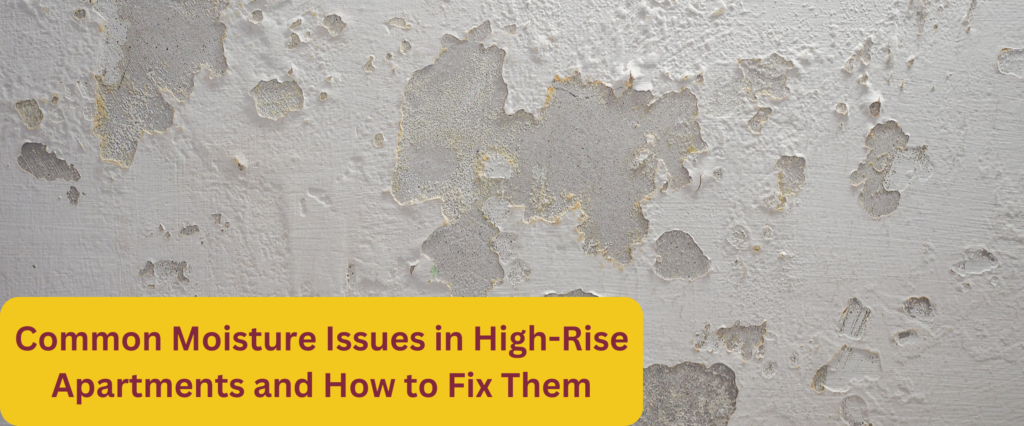
Living in a high-rise apartment comes with its unique set of challenges, and moisture-related problems rank among the most common concerns for both residents and property managers. Understanding these issues and knowing how to address them properly can help maintain a healthy living environment and protect your investment. Let’s explore the most frequent moisture problems in high-rise buildings and discuss effective solutions.
The Stack Effect: A High-Rise Challenge
One of the most significant factors affecting moisture in high-rise buildings is the stack effect – the vertical movement of air caused by temperature differences between the inside and outside of the building. This phenomenon can intensify moisture-related issues, especially during extreme weather conditions.
How the Stack Effect Impacts Moisture:
- Creates pressure differences that pull humid air upward
- Forces moisture into wall cavities and structural elements
- Can lead to condensation problems in upper floors
- May cause negative pressure in lower floors, drawing in outside moisture
Common Moisture Problems and Their Solutions
1. Condensation on Windows and Exterior Walls
Signs to Watch For:
- Water droplets on windows, especially during cold weather
- Wet windowsills or wall surfaces
- Mold growth around window frames
- Peeling paint or wallpaper
Solutions:
- Install proper ventilation systems
- Use dehumidifiers in problem areas
- Upgrade to double-pane or triple-pane windows
- Maintain consistent indoor temperature
- Consider applying anti-condensation coatings
2. Bathroom Moisture Issues
Common Problems:
- Steam buildup from showers
- Water damage around fixtures
- Mold growth on ceilings and walls
- Deteriorating grout and caulk
Solutions:
- Install high-quality exhaust fans
- Use mold-resistant materials during renovations
- Ensure proper ventilation during and after showers
- Regular maintenance of grout and caulk seals
- Consider humidity-sensing fans that run automatically
3. Plumbing Stack Problems
Warning Signs:
- Musty odors in bathrooms or kitchens
- Water stains on walls or ceilings
- Unexplained moisture in shared walls
- Paint bubbling or peeling
Solutions:
- Regular plumbing stack inspections
- Prompt repair of any leaks
- Maintenance of stack vent systems
- Professional cleaning of drain lines
- Installation of leak detection systems
Prevention Through Regular Inspections
Professional Inspection Schedule
Quarterly Inspections Should Include:
- Visual examination of all plumbing fixtures
- Checking window seals and frames
- Testing ventilation systems
- Monitoring humid areas for mold growth
- Examining exterior wall conditions
Annual Inspections Should Add:
- Thorough plumbing stack assessment
- Building envelope evaluation
- Thermal imaging to detect hidden moisture
- HVAC system performance review
- Roof and waterproofing inspection
Modern Solutions for Modern Buildings
Technology-Based Prevention:
1. Smart Monitoring Systems
- Wireless humidity sensors
- Automated ventilation controls
- Real-time leak detection
- Mobile alerts for maintenance staff
2. Advanced Materials
- Moisture-resistant drywall
- Self-sealing membranes
- Anti-microbial coatings
- High-performance insulation
Tips for Residents
1. Daily Practices:
- Use bathroom fans for 30 minutes after showers
- Keep windows clear of obstructions
- Report any signs of moisture promptly
- Maintain consistent indoor temperature
2. Seasonal Considerations:
- Adjust humidity levels seasonally
- Prepare for weather changes
- Monitor condensation during temperature extremes
- Follow building management guidelines
Conclusion
Moisture issues in high-rise apartments require a proactive approach combining regular inspections, proper maintenance, and resident awareness. By understanding these common problems and implementing appropriate solutions, building managers and residents can work together to maintain a dry, healthy living environment. Regular professional inspections remain the cornerstone of effective moisture management, helping to identify and address issues before they become major problems.
Remember that early detection and swift action are crucial in preventing moisture-related damage and maintaining the value and comfort of high-rise apartment living spaces. Through proper maintenance and vigilance, most moisture issues can be effectively managed or prevented entirely.
